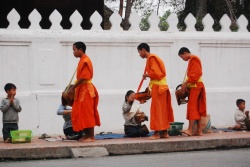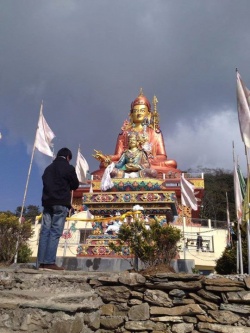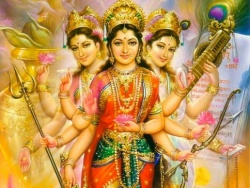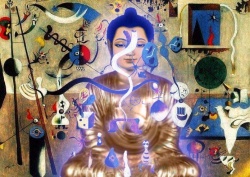Essay on the Spiritual Life of Buddhist Monks
While the experience of enlightenment is instantaneous, the approach to it is always gradual.
In Buddhism, therefore, the spiritual life consists essentially in the following of a path, the successive steps and stages of which have been carefully mapped out by tradition in accordance with the spiritual experience of the Buddha and his disciples, both immediate and remote.
As temperaments and methods of practice differ, this path can be formulated in various ways and the number and order of its constituent factors determined and described from various points of view.
Thus it denies about that we have not only the Aryan Eightfold Path, and the Path of the Ten Perfections and Ten Stages- two of the best-known formulations-but also the Path as consisting of seven stages of purification, thirteen 'abodes' (vihara), fifty-two yarns, and so on, the list being practically interminable.
What we may call the architectonic of the Path, however, does not vary, just as different types of bridges, built in accordance with the same principles of mechanics and for the same purpose, reveal the same basic structure.
This architectonic is most clearly exhibited in the formula of the Three Trainings (trisiksha), namely Morality (sila), Meditation (samadhi), and Wisdom (prajna), which according to one tradition was the recurrent theme of the discourses delivered by the Buddha during his last tour, and concerning which he is represented as declaring, 'Great becomes the fruit, great the advantage of samadhi, when it is set round with sila. Great becomes the fruit, great the advantage of prajna when it is set round with samadhi.
In its primary sense sila means 'behaviour' and in its derived sense good behaviour all behaviour, good or bad, is the expression of a mental attitude. Despite the formidable lists of precepts with which, in practice, Buddhist ethics has tended to become identified, sila is in the last analysis defined in purely psychological terms as those actions which are associated with wholesome mental states, productive of good karma, and dissociated from those which are unwholesome.
What constitutes a wholesome mental state differs from one Yana to another; or rather, there is a difference of emphasis.
For the Hinayana, good actions are those connected with the wholesome mental roots of non-greed (aloha), non-hate (advesha), and non-delusion (amolta); for the Mahayana and Vajrayana, those inspired by love (mailri) and compassion (karwja) for sentient beings.
Bodily and verbal actions being the extensions of mental states, these states can be induced by the performance of the actions, whether good or bad, self-regarding or altruistic, which is their natural expression. In this fact lies the importance of sila as a preparation for samadhi.
Samadhi or Meditation (the translation is approximate only) comprises the exercises by means of which the practitioner attains mental concentration and the super conscious states, as well as these states themselves.
It is the heart and center of the Buddhist spiritual life.
Broadly speaking, in the Hinayana the term samadhi generally refers to the practice of the meditation exercises, and in the Mahayana to the spiritual states attained by such practice.
Thirty-eight or forty meditation exercises are enumerated, but in fact there are more.
Among the most popular are the contemplation of the ten stages of decomposition of a corpse, by means of which craving (lobha) is destroyed, the cultivation of loving kindness (maitri) towards all sentient beings, which destroys hate (dvesha), and mindfulness of the bodily movements and the process of respiration, which leads to the destruction of delusion (moha).
The Mahayana makes use of the same exercises but combines them with the practice of Sunyata.
In the Vajrayana, meditation includes the repetition of the mantras of the Buddha's and Bodhisattvas and the visualization of their forms, which, after being conjured forth from the Voidness, worshipped, and meditated upon, are resolved back into.
There are also various exercises which, by manipulating the gross energies of the physical body, aim at activating their subtle and transcendental counterparts.
Whatever the type of exercise may be, the aim of it is to attain a state of purity and translucency of mind wherein the Truth can be as it were reflected.
In general prajna or Wisdom is threefold, as based upon learning (literally 'hearing'), upon independent thought and reflection, and upon meditation (bhavana, that which is mentally developed, or 'made to become').
Here the third kind or Wisdom proper is to be understood.
This may be described as a direct, non-conceptual apprehension of transcendental Reality.
For the Hinayana such apprehension arises when things and persons are viewed exclusively in terms of the dharmas, or ultimate elements of existence; for the Mahayana, when the dharmas themselves are seen as Sunyata.
In epithet case, the result is a permanent disruption of the web of illusion, resulting in Hinayana in the attainment of Archonship and in Mahayana of Supreme Buddhahood.
What, for want of a better word, we are compelled to term Buddhist philosophy is, in fact, essentially the conceptual formulation of the non-conceptual content of Wisdom or Enlightenment.
Correctly understood, the Sarvastivada, the Sautrantika, the Yogacara or Vijnanavada, and the Madhyamika are not rival systems of thought, one of which must be true and the rest false, but expressions on the intellectual plane of successively more advanced degrees of spiritual insight.
The technique is for a philosophy pertaining to a more advanced degree of insight to utilize the formulations of a less advanced degree in order to undermine its basic assumptions, thus impelling the practitioner to move from a more to a less limited experience of Reality.




